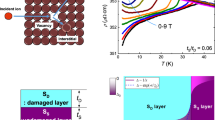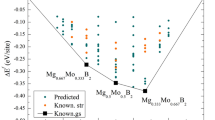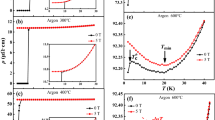Abstract
Magnesium diboride, MgB2, was recently observed to become superconducting1 at 39 K, which is the highest known transition temperature for a non-copper-oxide bulk material. Isotope-effect measurements, in which atoms are substituted by isotopes of different mass to systematically change the phonon frequencies, are one of the fundamental tests of the nature of the superconducting mechanism in a material. In a conventional Bardeen–Cooper–Schrieffer (BCS) superconductor, where the mechanism is mediated by electron–phonon coupling, the total isotope-effect coefficient (in this case, the sum of both the Mg and B coefficients) should be about 0.5. The boron isotope effect was previously shown to be large2 and that was sufficient to establish that MgB2 is a conventional superconductor, but the Mg effect has not hitherto been measured. Here we report the determination of the Mg isotope effect, which is small but measurable. The total reduced isotope-effect coefficient is 0.32, which is much lower than the value expected for a typical BCS superconductor. The low value could be due to complex materials properties, and would seem to require both a large electron–phonon coupling constant and a value of μ* (the repulsive electron–electron interaction) larger than found for most simple metals.
This is a preview of subscription content, access via your institution
Access options
Subscribe to this journal
Receive 51 print issues and online access
$199.00 per year
only $3.90 per issue
Buy this article
- Purchase on Springer Link
- Instant access to full article PDF
Prices may be subject to local taxes which are calculated during checkout



Similar content being viewed by others
References
Nagamatsu, J., Nakagawa, N., Muranaka, T., Zenitani, Y. & Akimitsu, J. Superconductivity at 39 K in magnesium diboride. Nature 410, 63–64 (2001).
Bud’ko, S. L. et al. Boron isotope effect in superconducting MgB2. Phys. Rev. Lett. 86, 1877–1880 (2001).
Cooper, A. S., Corenzwit, E., Longinotti, L. D., Matthias, B. T. & Zachariasen, W. H. Superconductivity: the transition temperature peak below four electrons per atom. Proc. Natl Acad. Sci. USA 67, 313–319 (1970).
Leyarovska, L. & Leyarovski, E. A search for superconductivity below 1K in transition metal borides. J. Less Common Met. 67, 249–255 (1979).
Kortus, J., Mazin, I. I., Belashchenko, K. D., Antropov, V. P. & Boyer, L. L. Superconductivity of metallic boron in MgB2. Preprint cond-mat/0101446 at 〈http://xxx.lanl.gov〉 (2001).
An, J. M & Pickett, W. E. Superconductivity of MgB2 from hole-doped covalent bonds. Preprint cond-mat/0102391 at 〈http://xxx.lanl.gov〉 (2001).
Kostic, P. et al. Paramagnetic Meissner effect in Nb. Phys. Rev. B 53, 791–801 (1996)
Lawrie, D. D. & Franck, J. P. Boron isotope effect in Ni and Pd based borocarbide superconductors. Physica C 245, 159–163 (1995).
Cheon, K. O., Fisher, I. R. & Canfield, P. C. Boron isotope effect in single-crystal YNi2B2C and LuNI2B2C superconductors. Physica C 312, 35–39 (1999).
Allen, P. B. & Dynes, R. C. Transition temperature of strong-coupled superconductors reanalyzed. Phys. Rev. B 12, 905–922 (1975)
McMillan, W. L. Transition temperature of strong-coupled superconductors. Phys. Rev. 167, 331–344 (1968).
Garland, J. W. Jr. Isotope effect in superconductivity. Phys. Rev. Lett. 11, 114–119 (1963).
Carbotte, J. P. Properties of boson-exchange superconductors. Rev. Mod. Phys. 62, 1027–1157 (1990).
Osborn, R., Goremychkin, E. A., Kolesnikov, A. I. & Hinks, D. G. Phonon density-of-states in MgB2. Phys. Rev. Lett. (in the press); also as preprint cond-mat/0103064 at 〈http://xxx.lanl.gov〉 (2001).
Kremer, R. K., Gibson, B. J. & Ahn, K. Heat capacity of MgB2: Evidence for moderately strong coupling behavior. Preprint cond-mat/ 0102432 at 〈http://xxx.lanl.gov〉 (2001).
Kotegawa, H., Ishida, K., Kitaoka, Y., Muranaka, T. & Akimitsu, J. Evidence for strong-coupling s-wave superconductivity in MgB2: 11B NMR study. Preprint cond-mat/0102334 at 〈http://xxx.lanl.gov〉 (2001).
Rubio-Bollinger, G., Suederow, H. & Vieira, S. Tunneling spectroscopy in small grains of superconducting MgB2. Preprint cond-mat/0102242 at 〈http://xxx.lanl.gov〉 (2001).
Karapetrov, G., Iavarone, M., Kwok, W. K., Crabtree, G. W. & Hinks, D. G. Scanning tunneling spectroscopy in MgB2. Phys. Rev. Lett. (in the press); also as preprint cond-mat/0102312 at 〈http://xxx.lanl.gov〉 (2001).
Schmidt, H., Zasadzinski, J. F., Gray, K. E. & Hinks, D. G. Energy gap from tunneling and metallic Sharvin contacts into MgB2: evidence for a weakened surface layer. Phys. Rev. B (in the press); also as preprint cond-mat/0102389 at 〈http://xxx.lanl.gov〉 (2001).
Sharoni, A., Felner, I. & Millo, O. Tunneling spectroscopy and magnetization measurements of the superconductor properties of MgB2. Phys. Rev. B (in the press); also as preprint cond-mat/0102325 at 〈http://xxx.lanl.gov〉 (2001).
Kong, Y., Dolgov, O. V., Jepsen, O. & Anderson, O. K. Electron-phonon interaction in the normal and superconducting states of MgB2. Phys. Rev. B (in the press); also as preprint cond-mat/0102499 at 〈http://xxx.lanl.gov〉 (2001).
Yildirim, T. et al. Giant anharmonicity and non-linear electron-phonon coupling in Mg B2: combined first principles calculations and neutron scattering study. Preprint cond-mat/0103469 at 〈http://xxx.lanl.gov〉 (2001).
Acknowledgements
This work was supported by the US Department of Energy, Office of Science.
Author information
Authors and Affiliations
Corresponding author
Rights and permissions
About this article
Cite this article
Hinks, D., Claus, H. & Jorgensen, J. The complex nature of superconductivity in MgB2 as revealed by the reduced total isotope effect. Nature 411, 457–460 (2001). https://doi.org/10.1038/35078037
Received:
Accepted:
Issue Date:
DOI: https://doi.org/10.1038/35078037
This article is cited by
-
A Complete and Accurate Description of Superconductivity of AlB2-Type Structures from Phonon Dispersion Calculations
Journal of Superconductivity and Novel Magnetism (2018)
-
Improving the Critical Temperature of MgB2 Superconducting Metamaterials Induced by Electroluminescence
Journal of Superconductivity and Novel Magnetism (2016)
Comments
By submitting a comment you agree to abide by our Terms and Community Guidelines. If you find something abusive or that does not comply with our terms or guidelines please flag it as inappropriate.



